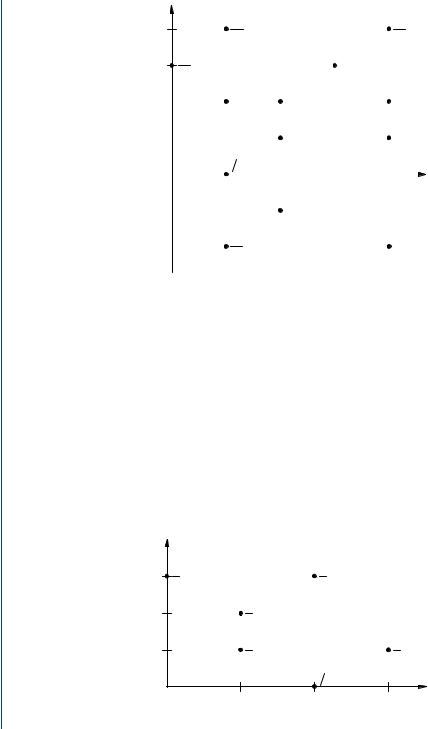
Intermediate Probability Theory for Biomedical Engineers - JohnD. Enderle
.pdf
|
|
|
|
|
|
BIVARIATE RANDOM VARIABLES 93 |
36. |
The joint PDF of random variables x and y is |
|
||||
|
fx,y |
(α, β) |
= |
aα, α > 0, −1 < β − α < β < 0 |
||
|
|
|
0, |
otherwise. |
||
|
Event A = {0 > y > −0.5}. Determine (a) a, (b) fx (α), (c) fy (β), (d) E(x), (e) E(y), |
|||||
|
(f ) E(x2), (g) E(y2), (h) E(xy), (i) σx2, (j) σy2, (k) σx,y , (l) fx,y| A(α, β | A), (m) E(x | A). |
|||||
37. |
Random variables x and y have joint PDF |
|
||||
|
fx,y |
(α, β) |
= |
0.6(α + β2), 0 < α < 1, |β| < 1 |
||
|
|
0, |
otherwise. |
|||
Determine: (a) E(x), (b) E(y), (c) σx2, (d) σy2, (e) σx,y , (f ) E(y | x = α), (g) E(x | y = β),
(h) σy2|x , (i) σx2|y .
38.Given
|
fx,y |
(α, β) |
= |
1.2(α2 + β), 0 ≤ α ≤ 1, 0 ≤ β ≤ 1 |
|||||
|
|
|
|
|
0, |
otherwise. |
|||
Event A = {y < x}. Determine: (a) ηy , (b) ηx|y=1/2, (c) E(x | A), (d) σx,y , (e) σx,y| A, |
|||||||||
(f ) σ 2 |
, (g) σ 2 |
|
. |
|
|
|
|
|
|
x|y=1/2 |
x| A |
|
|
|
|
|
|
|
|
39. Random variables x and y have joint PDF |
|
||||||||
|
fx,y |
(α, β) |
= |
β sin(α), 0 ≤ α ≤ π, 0 ≤ β ≤ 1 |
|||||
|
|
|
0, |
otherwise. |
|||||
Event A = {y ≥ 0.5} and B = {x > y}. Determine: (a) E(x | A), (b) E(y | A), (c) E(x | |
|||||||||
B), (d) E(y | B), (e) ρx,y , (f ) ρx,y| A. |
|
||||||||
40. If random variables x and y have joint PDF |
|
||||||||
|
fx,y |
(α, β) |
= |
0.5β exp(−α), |
α ≥ 0, 0 ≤ β ≤ 2 |
||||
|
|
|
|
0, |
otherwise, |
||||
determine: (a) σx,y , (b) ρx,y , (c) E(y | x = α), (d) σx|y . 41. The joint PDF for random variables x and y is
fx,y |
(α, β) |
= |
10α2β, 0 ≤ β ≤ α ≤ 1 |
|
|
0, |
otherwise. |
||
Event A = {x + y > 1}. Determine: (a) |
E(y | x = 3/4), (b) E(y | A), (c) E(y2 | A), |
|||
(d) E(5y2 − 3y + 2 | A), (e) σy2| A, (f ) σy2|x=3/4.

94INTERMEDIATE PROBABILITY THEORY FOR BIOMEDICAL ENGINEERS
42.Random variables x and y have joint PDF
fx,y |
(α, β) |
= |
|
a(αβ + 1), 0 < α < 1, 0 < β < 1 |
|||||||
|
|
|
|
|
|
0, |
|
otherwise. |
|||
Event A = {x > y}. Find: (a) a, |
(b) |
fy (β), |
(c) fx|y (α | β), (d) E(y), (e) E(x | y), |
||||||||
(f ) E(xy), (g) P (A), (h) |
fx,y| A(α, β | A), (i) E(xy | A). |
||||||||||
43. Let random variables x and y have joint PDF |
|
||||||||||
|
fx,y |
(α, β) |
= |
1/16, 0 ≤ α ≤ 8, |β| ≤ 1 |
|||||||
|
|
|
|
|
0, |
otherwise. |
|||||
Random variable z = yu(y). Determine: (a) σx , (b) σy , (c) σz. |
|||||||||||
44. Random variables x and y have joint PDF |
|
||||||||||
|
fx,y |
(α, β) |
= |
|
3(α2 |
+ β2), 0 ≤ β ≤ α ≤ 1 |
|||||
|
|
|
|
|
|
|
0, |
otherwise. |
|||
Event A = {x2 + y2 ≤ 1}. Determine: (a) σx,y , (b) ρx,y , (c) σx,y| A, (d) ρx,y| A. |
|||||||||||
45. The joint PDF for random variables x and y is |
|
||||||||||
|
|
|
|
|
|
|
|
9 |
α2β2, 0 ≤ β ≤ 2, 1 ≤ α ≤ 3 |
||
fx,y (α, β) = |
|
|
|
||||||||
|
|
208 |
|||||||||
|
|
|
|
|
|
|
|
|
0, |
|
otherwise. |
Determine: (a) σx2, (b) E(x | y), (c) whether x and y are independent, (d) E(g (x)) if g (x) = 26 sin(π x)/3, (e) E(h(x, y)) if h(x, y) = xy.
46. Suppose random variables x and y are independent with
fx,y |
(α, β) |
= |
2 exp(−2α), |
α > 0, 0 ≤ β ≤ 1 |
|
0, |
otherwise. |
Determine E(y(x + y)).
47.Prove the following properties: (a) Given random variable x and constants a and b, E(a x + b) = a E(x) + b. (b) Given independent random variables x and y, E(xy) = E(x)E(y). (c) Given random variable x, constants a and b, and an event A, E(a x + b | A) = a E(x | A) + b. (d) Given that random variables x and y are conditionally independent, given event A, E(xy | A) = E(x | A)E(y | A).
48.Random variables x and y have the joint PDF
1
fx,y (α, β) = 4 (u(α) − u(α − 2))(u(β) − u(β − 2)).
If z = x + y, use convolution to find fz.

BIVARIATE RANDOM VARIABLES 95
49. Random variables x and y are independent with
fx (α) = e −α u(α)
and
fy (β) = 2e −2β u(β).
If z = x + y, use convolution to find fz.
50. Independent random variables x and y have PDFs
fx (α) = 2e −2α u(α)
and
12 (u(β + 1) − u(β − 1)).
Find fz if z = x + y. Use convolution.
51. Random variables x and y are independent and RV z = x + y. Given
fx (α) = u(α − 1) − u(α − 2)
and |
|
|
|
|
|||
1 |
|
(u(β) − u(β − |
√ |
|
|
||
|
|
||||||
fy (β) = |
√ |
|
|
2)), |
|||
2 |
|
||||||
use convolution to find fz.
52. Random variables x and y are independent with
fx (α) = 2e −2α u(α)
and
1
fy (β) = 2 (u(β + 1) − u(β − 1)).
With z = x + y, use the characteristic function to find fz.
53.An urn contains four balls labeled 1, 2, 3, and 4. An experiment involves drawing three balls one after the other without replacement. Let RV x denote the sum of numbers on first two balls minus the number on the third. Let RV y denote the product of the numbers on the first two balls minus the number on the third. Event A = {either x or y is negative}. Determine: (a) px,y (α, β); (b) px (α); (c) py (β);
(d) py|x (β | 5); (e) px|y (α | 5); (f ) E(y | x = 5); (g) σy2|x=5; (h) px,y| A(α, β | A); (i) E(x| A);
(j) whether or not x and y are independent; (k) whether or not x and y are independent, given A; (l) σx,y ; and (m) σx,y| A.

96 INTERMEDIATE PROBABILITY THEORY FOR BIOMEDICAL ENGINEERS
TABLE 4.1: Joint PMF for Problems 54–59.
α |
β = 0 |
β = 1 |
β = 2 |
0 |
6/56 |
18/56 |
6/56 |
|
|
|
|
1 |
12/56 |
11/56 |
1/56 |
|
|
|
|
2 |
1/56 |
0 |
1/56 |
|
|
|
|
54. |
Random variables x and y have the joint PMF given in Table 4.1. Event A = {x + y ≤ |
||
|
2}. Determine: (a) px ; (b) py ; (c) px|y (α | 0); (d) py|x (β | 1); (e) px,y| A(α, β | A); (f ) px| A; |
||
|
(g) py| A; (h) whether or not x and y are independent; (i) whether or not x and y are |
||
|
independent, given A. |
|
|
55. |
Random variables x and y have the joint PMF given in Table 4.1. Event A = {x + |
||
|
y ≤ 2}. Determine: (a) E(x), (b) E(x2), (c) σx2, (d) E(5x), (e) σ22x+1, (f ) E(x − 3x2), |
||
|
(g) E(x | A), (h) E(x2 | A), (i) E(3x2 − 2x | A). |
|
|
56. |
Random variables x and y have the joint PMF given in Table 4.1. Event A = {x + y ≤ |
||
|
2}. Determine: (a) E(y), (b) E(y2), (c) σy2, (d) E(5y − 2), (e) σ32y , (f ) E(5y − y2), |
||
|
(g) E(y | A), (h) E(y2 | A), (i) E(3y2 − 2y | A). |
|
|
57. |
Random variables x and y have the joint PMF given in Table 4.1. Event A = {x + y ≤ |
||
|
2}. If w(x, y) = x + y, then determine: (a) pw, (b) pw|A, (c) E(w), (d) E(w | A), (e) σw2 , |
||
|
(f ) σ 2 |
. |
|
|
w|A |
|
|
58. |
Random variables x and y have the joint PMF given in Table 4.1. Event A = {x + y ≤ |
||
|
2}. If z(x, y) = x2 − y, then determine: (a) pz, (b) pz|A, (c) E(z), (d) E(z| A), (e) σz2, |
||
|
(f ) σ 2 |
. |
|
|
z| A |
|
|
59. |
Random variables x and y have the joint PMF given in Table 4.1. Event B = {zw > 0}, |
||
|
where w(x, y) = x + y, and z(x, y) = x2 − y. Determine: (a) |
pz,w, (b) pz, (c) pw, |
|
|
(d) pz|w(γ | 2), (e) pz|B , (f ) ηz, (g) ηz|B , (h) σz2, (i) |
σz2|B , (j) σz,w, (k) |
|
|
σz,w|B . |
|
|
60.Random variables x and y have joint PMF shown in Fig. 4.19. Event A = {xy ≥ 1}. Determine: (a) px ; (b) py ; (c) px|y (α | 1); (d) py|x (β | 1); (e) px,y| A(α, β | A); (f ) px| A;
(g)py| A; (h) whether or not x and y are independent; (i) whether or not x and y are independent, given A.
61.Random variables x and y have joint PMF shown in Fig. 4.19. Event A = {xy ≥ 1}. Determine: (a) E(x), (b) E(x2), (c) σx2, (d) E(x − 1), (e) σ32x , (f ) E(5x − 3x2),
(g)E(x | A), (h) E(x2 | A), (i) E(x2 + 2x | A).

BIVARIATE RANDOM VARIABLES 97
b |
1 |
|
|
1 |
|
2 |
|
|
|
||
6 |
|
|
6 |
|
|
|
|
|
|
||
1 |
1 |
1 |
|
1 |
|
12 |
12 |
|
12 |
|
|
|
|
|
|||
1 12 |
|
|
|
1 12 |
|
0 |
1 |
2 |
3 |
4 |
a |
|
|||||
|
|
1 1
-1 
12 6
FIGURE 4.19: PMF for Problems 60–65.
62.Random variables x and y have joint PMF shown in Fig. 4.19. Event A = {xy ≥
1}. Determine: (a) E(x + y), (b) E(y2), (c) σy2, (d) E(5y − x), (e) σx2,y , (f ) σx,y| A,
(g) E(x + y | A), (h) E(x2 + y2 | A), (i) E(3y2 − 2x | A).
63.Random variables x and y have joint PMF shown in Fig. 4.19. Event A = {xy ≥ 1}.
|
If w(x, y) = |x − y|, then determine: (a) pw, (b) pw| A, (c) E(w), (d) E(w | A), (e) σw2 , |
||
|
(f ) σ 2 |
|
. |
|
w| A |
|
|
64. |
Random variables x and y have joint PMF shown in Fig. 4.19. Event A = {xy ≥ 1}. |
||
|
If z(x, y) = 2x − y, then determine: (a) pz, (b) pz| A, (c) E(z), (d) E(z| A), (e) σz2, |
||
|
(f ) σ 2 |
. |
|
|
z| A |
|
|
65. |
Random variables x and y have joint PMF shown in Fig. 4.19. Event B = {z + w ≤ 2}, |
||
|
where w(x, y) = |x − y|, and z(x, y) = 2x − y. Determine: (a) pz,w, (b) pz, (c) pw, |
||
|
(d) pz|w(γ | 0), (e) pz|B , (f ) ηz, (g) ηz|B , (h) σz2, (i) σz2|B , (j) σz,w, (k) σz,w|B . |
||
66. |
Random variables x and y have joint PMF shown in Fig. 4.20. Event A = {x > 0, y > |
||
|
0} and event B = {x + y ≤ 3}. Determine: (a) px ; (b) py ; (c) px|y (α | 2); (d) py|x (β | 4); |
||
(e)px,y| Ac ∩B (α, β | Ac ∩ B); (f ) px| Ac ∩B ; (g) py| Ac ∩B ; (h) whether or not x and y are independent; (i) whether or not x and y are independent, given Ac ∩ B.
67.Random variables x and y have joint PMF shown in Fig. 4.20. Event A = {x > 0, y > 0} and event B = {x + y ≤ 3}. Determine: (a) E(x), (b) E(x2), (c) σx2, (d) E(x − 2y),
(e)σ22x , (f ) E(5x − 3x2), (g) E(x | A ∩ B), (h) E(x2 | A ∩ B), (i) E(3x2 − 2x | A ∩ B).
68. Random variables x and y have joint PMF shown in Fig. 4.20. Event A = {x > 0, y > 0} and event B = {x + y ≤ 3}. Determine: (a) E(y), (b) E(y2), (c) σy2, (d) E(5y − 2x2), (e) σ32y , (f ) E(5y − 3y2), (g) E(x + y | A ∩ B), (h) E(x2 + y2 | A ∩ B),
(i) E(3y2 − 2y | A ∩ B).
69.Random variables x and y have joint PMF shown in Fig. 4.20. Event A = {x > 0, y >
0}. If w(x, y) = y − x, then determine: (a) pw, (b) pw| Ac , (c) E(w), (d) E(w | Ac ),
(e) σw2 , (f ) σw2| Ac .

98 INTERMEDIATE PROBABILITY THEORY FOR BIOMEDICAL ENGINEERS
b |
|
1 |
2 |
4 |
19 |
19 |
1 |
|
|
|
|
|
|
|
|
1 |
|
|
|
|
|
||||
3 |
|
|
|
|
|
|
|
|
|
|
|
|
|
|
|
|
|
|
|
|
|
|
|
|
|
|
|
|
|
19 |
|
|
|
|
|
||
19 |
|
|
|
|
|
|
|
|
|
|
|
|
|
|||||
2 |
|
2 |
|
|
|
|
|
|
1 |
|
||||||||
2 |
|
|
|
|
|
|
|
|
|
|
|
|
|
|
|
|
|
|
|
|
|
|
|
|
19 |
|
|
|
|
|
|
19 |
|
||||
19 |
|
|
|
|
|
|
|
|
||||||||||
1 |
|
|
|
|
|
|
1 |
|
|
|
|
|
|
1 |
|
|||
|
|
|
|
|
|
|
|
|
|
|
|
|
|
|
|
|
|
|
|
|
|
|
|
|
19 |
|
|
|
|
|
|
19 |
|
||||
|
|
|
|
|
|
|
|
|
|
|
|
|
|
|||||
1 19 |
|
|
|
|
|
|
|
|
|
|
|
|
||||||
0 |
|
|
|
|
|
|
|
|
|
|
|
|
|
|
|
|
|
|
1 |
|
|
2 |
|
3 |
4 |
|
|
a |
|||||||||
-1 |
|
|
|
|
|
|
3 |
|
|
|
|
|
|
|
|
|
||
|
|
|
|
|
|
|
|
|
|
|
|
|
|
|
|
|
|
|
|
|
|
|
|
|
19 |
|
|
|
|
|
|
|
|
|
|||
|
|
|
|
|
|
|
|
|
|
|
|
|
|
|
|
|||
1 |
|
|
|
|
|
|
|
|
|
|
2 |
|
||||||
-2 |
|
|
|
|
|
|
|
|
|
|
|
|
|
|
|
|
|
|
|
|
|
|
|
|
|
|
|
|
|
|
|
|
|
19 |
|
||
19 |
|
|
|
|
|
|
|
|
|
|
|
|||||||
FIGURE 4.20: PMF for Problems 66–71.
70. |
Random variables x and y have joint PMF shown in Fig. 4.20. Event A = {x > 0, y > |
|
|
0}. If z(x, y) = xy, then determine: (a) pz, (b) pz| Ac , (c) E(z), (d) E(z| Ac ), (e) σz2, |
|
|
(f ) σ 2 |
. |
|
z| A |
|
71. |
Random variables x and y have joint PMF shown in Fig. 4.20. Event B = {z + w ≤ 1}, |
|
|
where w(x, y) = y − x, and z(x, y) = xy. Determine: (a) pz,w, (b) pz, (c) pw, (d) |
|
|
pz|w(γ | 0), (e) pz|B , (f ) ηz, (g) ηz|B , (h) σz2, (i) σz2|B , (j) σz,w, (k) σz,w|B . |
|
72.Random variables x and y have joint PMF shown in Fig. 4.21. Event A = {2 ≤ x + y < 5}. Determine: (a) px , (b) py , (c) px,y| A, (d) px| A, (e) py| A.
|
b |
|
|
|
6 |
1 |
1 |
|
|
8 |
8 |
|
|
|
|
|
|
||
4 |
1 |
|
|
|
4 |
|
|
|
|
|
|
|
|
|
2 |
1 |
|
|
1 |
8 |
|
|
4 |
|
|
|
|
||
|
|
1 8 |
|
a |
0 |
1 |
2 |
3 |
FIGURE 4.21: PMF for Problems 72–77.

BIVARIATE RANDOM VARIABLES 99
73.Random variables x and y have joint PMF shown in Fig. 4.21. Event A = {2 ≤ x + y <
5}. Determine: (a) E(x), (b) E(x2), (c) σx2, (d) E(3x + 4x2 − 5), (e) σ22x+5, (f ) E(x | A),
(g) E(x2 | A), (h) E(3x + 4x2 − 5 | A).
74.Random variables x and y have joint PMF shown in Fig. 4.21. Event A = {2 ≤ x + y <
5}. Determine: (a) E(3x + y), (b) E(y2 + x2), (c) E(4y + 3y2 − 1), (d) σy2, (e) σx,y , (f ) σ32y+2x , (g) E(x + y | A), (h) E(y | x = 2), (i) E(x2 + y2 | A), (j) σy2| A, (k) σx,y| A,
(l)σx2+y| A.
75.Random variables x and y have joint PMF shown in Fig. 4.21. Event A = {2 ≤ x + y < 5}. If w(x, y) = max(x, y), then determine: (a) pw, (b) pw| A, (c) E(w), (d) E(w | A),
(e)σw2 , (f ) σw2| A.
76.Random variables x and y have joint PMF shown in Fig. 4.21. Event A = {2 ≤ x + y <
5}. If z(x, y) = min(x, y), then determine: (a) pz, (b) pz| A, (c) E(z), (d) E(z| A), (e) σz2, (f ) σz2| A.
77.Random variables x and y have joint PMF shown in Fig. 4.21. Event B = {z − 2w >
1}, where w(x, y) = max(x, y), and z(x, y) = min(x, y). Determine: (a) pz,w, (b) pz,
(c) pw, (d) pz|w(γ | 0), (e) pz|B , (f ) ηz, (g) ηz|B , (h) σz2, (i) σz2|B , (j) σz,w, (k) σz,w|B .
78.Random variables x and y have the joint PMF shown in Fig. 4.22. Event A = {x < 4}, event B = {x + y ≤ 4}, and event C = {xy < 4}. (a) Are x and y independent RVs? Are x and y conditionally independent, given: (b) A, (c) B, (d) C, (e) Bc ?
79.Prove that if
g (x, y) = a1g1(x, y) + a2g2(x, y)
then
E(g (x, y)) = a1 E(g1(x, y)) + a2 E(g2(x, y)).
6 |
|
|
b |
1 |
|
|
1 |
|
|
1 |
||||||
|
|
|
|
|
||||||||||||
|
|
|
|
|
|
|
|
|||||||||
|
|
|
|
|
|
|
|
|
|
|
|
|
|
|
8 |
|
|
|
|
|
16 |
|
|
16 |
|
|
|||||||
|
|
|
|
|
|
|
|
|
||||||||
4 |
|
|
|
|
|
1 |
|
|
|
1 |
|
|
1 |
|||
|
|
|
|
16 |
|
|
16 |
|
|
8 |
||||||
|
|
|
|
|
|
|
|
|
||||||||
2 |
|
|
|
|
|
1 |
|
|
|
|
1 |
|
|
|
1 |
|
|
|
|
|
8 |
|
|
|
8 |
|
|
|
4 |
||||
|
|
|
|
|
|
|
|
|
|
|
||||||
|
|
|
|
|
|
|
|
|
|
|
|
|
|
|
|
|
|
|
|
|
|
|
|
|
|
|
|
|
|
|
|
|
|
0 |
|
1 |
2 |
3 |
|
|
4 |
a |
||||||||
|
|
|
|
|
||||||||||||
FIGURE 4.22: PMF for Problems 78.

100INTERMEDIATE PROBABILITY THEORY FOR BIOMEDICAL ENGINEERS
80.Prove that if z = g (x) then
E(z) = g (α) px (α).
α
81.Let event A = {g (x, y)}, where g (x, y) is an arbitrary (measurable) function of the discrete RVs x and y. Prove or give a counter example:
px| A(α | A) = px (α) .
P (A)
82.Let event A = {g (x, y)}, where g (x, y) is an arbitrary (measurable) function of the discrete RVs x and y. The RVs x and y are conditionally independent, given event A. Prove or give a counter example:
px| A(α | A) = px (α) .
P (A)
83. Random variables x and y are independent. Prove or give a counter example:
E |
x |
= |
E(x) |
|
|
|
. |
||
y |
E(y) |
|||
84. Random variables x and y are independent with marginal PMFs
|
|
|
1/3, |
α = −1 |
|||
px |
(α) |
= |
4/9, |
α = 0 |
|||
|
2 |
/ |
, |
α |
= 1 |
||
|
|
|
9 |
|
|
||
|
|
|
0, |
|
otherwise, |
||
and |
|
|
|
|
|
|
|
|
|
|
1/4, |
β = 0 |
|||
py |
(β) |
= |
1/4, |
β = 1 |
|||
|
1 |
/ |
, |
β |
= 2 |
||
|
|
|
2 |
|
|
||
|
|
|
|
0, |
|
otherwise. |
|
Event A = {min(x, y) ≤ 0}. Determine: (a) px,y ; (b) whether or not x and y are independent, given A; (c) E(x + y); (d) E(x + y | A); (e) E(xy); (f ) ρx,y ; (g) ρx,y| A.
85.Random variables x and y satisfy: E(x) = 10, σx = 2, E(y) = 20, σy = 3, and σx,y = −2. With z = z(x, y) = x + y, determine: (a) ρx,y , (b) σ2x , (c) E(z), and (d) σz.
86.Random variables x and y satisfy: ηx = 5, ηy = 4, σx,y = 0, σx = 4, and σy = 5. Determine: (a) E(3x2 + 5x + 1), (b) E(xy), (c) σ3x+2y , (d) whether or not x and y are independent RVs.

BIVARIATE RANDOM VARIABLES 101
87.A course in random processes is taught at Fargo Polytechnic Institute (FPI). Due to scheduling difficulties, on any particular day, the course could be taught in any of the rooms A, B, or C. The following a priori probabilities are known
P (A) = 12 , P (B) = 13 , P (C) = 16 ,
where events A, B, and C denote the events that the course is taught in room A, B, and C, respectively. Room A contains 60 seats, room B contains 45 seats, and room C contains 30 seats. Sometimes there are not enough seats because 50 students are registered for the course; however, they do not all attend every class. In fact, the probability that exactly n students will attend any particular day is the same for all possible n {0, 1, . . . , 50}.
(a) What is the expected number of students that will attend class on any particular day? (b) What is the expected number of available seats in the class on any particular day? (c) What is the probability that exactly 25 seats in the class will not be occupied on any particular day? (d) What is the probability that there will not be enough seats available for the students who attend on any particular day?
Besides having trouble with scheduling, FPI is also plagued with heating problems. The temperature t in any room is a random variable which takes on integer values (in degrees Fahrenheit). In each room, the PMF pt (τ ) for t is constant over the following ranges:
Room A: 70 ≤ τ ≤ 80,
Room B: 60 ≤ τ ≤ 90,
Room C: 50 ≤ τ ≤ 80;
outside these ranges, the PMF for t is zero.
(e) What is the PMF for the temperature experienced by the students in class? (f ) Given that the temperature in class today was less than 75 degrees, what is the probability that today’s class was taught in room A?
88. Random variables x1 and x2 are independent, identically distributed with PMF
px1 |
(α) |
= |
a/α2, α = −3, −2, 1, 4, |
|
|
0, |
otherwise. |
||
Random variable y = x1 + x2 and event A = {x1 + x2}. Find: (a) a, (b) P (x1 > x2),
(c) py , (d) E(y), (e) E(y | A), (f ) σy2, (g) σy2| A.

102INTERMEDIATE PROBABILITY THEORY FOR BIOMEDICAL ENGINEERS
89.Random variables x1 and x2 are independent, identically distributed with PMF
|
|
3 |
(0.3)k (0.7)3−k , k = 0, 1, 2, 3 |
||
px1 (k) = |
k |
||||
0, |
otherwise. |
||||
|
|
|
|||
2 |
, (c) E(x1 |
|
2 |
, (e) P (x1 ≤ x2 + 1). |
|
Find: (a) E(x1), (b) σx1 |
|x1 > 0), (d) σx1|x1>0 |
||||
90.The Electrical Engineering Department at Fargo Polytechnic Institute has an outstanding bowling team led by Professor S. Rensselear. Because of her advanced age, the number of games she bowls each week is a random variable with PMF
|
(α) |
|
a − |
α |
, α = 0, 1, 2 |
px |
= |
12 |
|||
|
0, |
otherwise. |
|||
To her credit, Ms. Rensselear always attends each match to at least cheer for the team when she is not bowling. Let x1, . . . , xn be n independent, identically distributed random variables with xi denoting the number of games bowled in week i by Prof. Rensselear. Define the RVs z = max(x1, x2) and w = min(x1, x2). Determine: (a) a,
(b) P (x1 > x2), (c) P (x1 + x2 + · · · + xx ≤ 1), (d) pz,w, (e) E(z), (f ) E(w), (g) σz,w.
91.Professor S. Rensselear, a very popular teacher in the Electrical Engineering Department at Fargo Polytechnic Institute, gets sick rather often. For any week, the probability she will miss exactly α days of days of lecture is given by
1/8, |
α = 0 |
1/2, |
α = 1 |
px (α) = 1/4, |
α = 2 |
1/8, |
α = 3 |
0, |
otherwise. |
The more days she misses, the less time she has to give quizzes. Given that she was sick α days this week, the conditional PMF describing the number of quizzes given is
1 |
, |
1 ≤ β ≤ 4 − α |
|
py|x (β | α) = |
4 − α |
||
0, |
|
otherwise. |
|
Let y1, y2, · · ·, yn denote n independent, identically distributed RVs, each distributed as y. Additionally, the number of hours she works each week teaching a course on probability theory is w = 10 − 2x + y, and conducting research is z = 20 − x2 + y. Determine: (a) py , (b) px,y , (c) px|y (α | 2), (d) P (y1 > y2), (e) P (y1 + y2 + · · · + yn >
